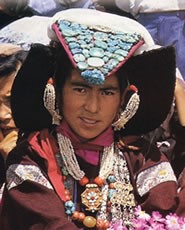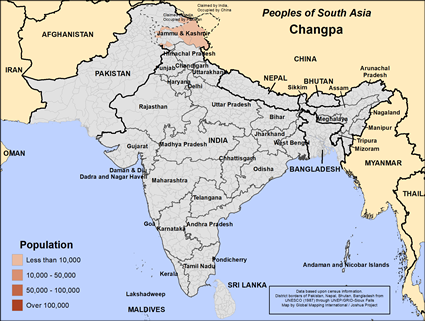Changpa in India

Photo Source:
Anonymous
|

Map Source:
People Group data: Omid. Map geography: UNESCO / GMI. Map Design: Joshua Project.
|
| People Name: | Changpa |
| Country: | India |
| 10/40 Window: | Yes |
| Population: | 2,700 |
| World Population: | 2,700 |
| Primary Language: | Changthang |
| Primary Religion: | Buddhism |
| Christian Adherents: | 0.19 % |
| Evangelicals: | 0.00 % |
| Scripture: | Portions |
| Ministry Resources: | No |
| Jesus Film: | No |
| Audio Recordings: | Yes |
| People Cluster: | South Asia Tribal - other |
| Affinity Bloc: | South Asian Peoples |
| Progress Level: |
|
Introduction / History
In 1989 the Changpa were granted official status in India as a scheduled tribe. Before then they were considered a sub-group of the Ladakhi, but their customs, language and ethnicity are different from those of the Ladakhi. They are also distinct from the Zangskari people, with whom the Changpa barter to obtain grain.
The Changpa language is closely related to Ladakhi, and most Changpa have no problem understanding Ladakhi when they travel outside their remote valleys for trade.
Primarily located along the southern border area between Tibet and the Indian state of Jammu and Kashmir, the Changpa people live east and south-east of the city of Leh. The area inhabited by the Changpa in Jammu and Kashmir is extremely cold. Living at an average altitude of 4,000 to 5,000 metres (13,000 to 16,000 ft.) above sea level, the Changpa homeland is ravaged by snowstorms during the long winter months.
What Are Their Lives Like?
Most Changpa people are pastoralists. They raise sheep and goats, and they are particularly noted for the cashmere wool they produce. The Changpa can be identified by their conical yak-skin tents called reboo. The Changpa who live nomadic lives are known as Phalpa, while those who have settled down in fixed locations are called Fangpa. The ruling aristocracy is known as the Nono.
The diet of the Changpa people consists of barley and the meat of yak and wild horses. They also eat dried cheese and meat boiled with barley flour and seasoned with chilies.
What Are Their Beliefs?
All Changpa families profess Tibetan Buddhism as their religion. It has a central place in their culture. Each tent invariably accommodates the family deity, Donaq, and a picture of their spiritual head, the Dalai Lama. They worship their family deity on the fifteenth day of the seventh Buddhist month. The Bon heritage is quite conspicuous in the Changpa religion despite the efforts of the Buddhists to erase it. Another source states, "Buddhism rests quite lightly on them, as they have more faith in their traditional beliefs and practices. In this form of primitive religion, a carryover from the early bon religion, the lha (spirits) and lhu (serpents) are considered very important. The world of lhas and lhus is believed to be complex and fearful. For every unwelcome event, be it harsh weather, or death, one of the lhas or lhus is responsible. The supreme lha is known as Changmen, who is believed to control about 360 lhas in the Changthang area.
What Are Their Needs?
The Changpa could surely be ranked among the most unreached people groups in the world. Because of their remarkably isolated existence, very few have ever been exposed to the gospel, which has failed to penetrate this remote part of the world.
Prayer Points
Pray for the authority of Christ to bind hindering spiritual forces to lead them from darkness to light.
Pray for signs and wonders among them and for great breakthroughs with a rapid multiplication of disciples and house churches.
Pray for bold workers who are driven by the love of the Holy Spirit to go to them.
Pray for an unstoppable movement to Christ among them.